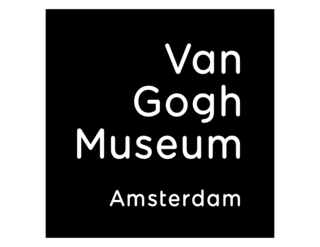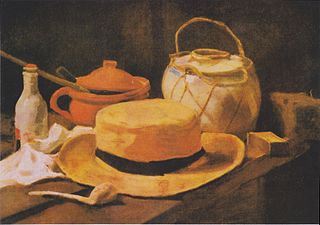
Vincent Willem van Gogh was a Dutch Post-Impressionist painter who is among the most famous and influential figures in the history of Western art. In just over a decade, he created approximately 2100 artworks, including around 860 oil paintings, most of them in the last two years of his life. His oeuvre includes landscapes, still lifes, portraits, and self-portraits, most of which are characterized by bold colors and dramatic brushwork that contributed to the rise of expressionism in modern art. Van Gogh's work was beginning to gain critical attention before he died from a self-inflicted gunshot at age 37. During his lifetime, only one of van Gogh's paintings, The Red Vineyard, was sold.

Nuenen, Gerwen en Nederwetten is a municipality consisting of the larger village of Nuenen and two adjacent smaller ones. It is located in the province of North Brabant, about 10 kilometres (6.2 mi) east of Eindhoven, the fifth largest city in the Netherlands. From being a small farmers town of less than 1000 inhabitants around 1950 Nuenen grew steadily as ever more new employees of Philips and the Eindhoven University (TUE) chose Nuenen as their new home.

The Van Gogh Museum is a Dutch art museum dedicated to the works of Vincent van Gogh and his contemporaries in the Museum Square in Amsterdam South, close to the Stedelijk Museum, the Rijksmuseum, and the Concertgebouw. The museum opened on 2 June 1973, and its buildings were designed by Gerrit Rietveld and Kisho Kurokawa.

Nuenen is a town in the municipality of Nuenen, Gerwen en Nederwetten in the Netherlands. From 1883 to 1885, Vincent van Gogh lived and worked in Nuenen. In 1944, a battle was fought there during Operation Market Garden. The local dialect is called Peellands. In 2009, Nuenen had a population of 22,437.

The Potato Eaters is an oil painting by Dutch artist Vincent van Gogh painted in April 1885 in Nuenen, Netherlands.
Vincent van Gogh lived during the Impressionist era. With the development of photography, painters and artists turned to conveying the feeling and ideas behind people, places, and things rather than trying to imitate their physical forms. Impressionist artists did this by emphasizing certain hues, using vigorous brushstrokes, and paying attention to highlighting. Vincent van Gogh implemented this ideology to pursue his goal of depicting his own feelings toward and involvement with his subjects. Van Gogh's portraiture focuses on color and brushstrokes to demonstrate their inner qualities and Van Gogh's own relationship with them.
The fame of Vincent van Gogh began to spread in France and Belgium during the last year of his life, and in the years after his death in the Netherlands and Germany. His friendship with his younger brother Theo was documented in numerous letters they exchanged from August 1872 onwards. The letters were published in three volumes in 1914 by Johanna van Gogh-Bonger, Theo's widow, who also generously supported most of the early Van Gogh exhibitions with loans from the artist's estate. Publication of the letters helped spread the compelling mystique of Vincent van Gogh, the intense and dedicated painter who died young, throughout Europe and the rest of the world.

Cottages is a subject of paintings created by Vincent van Gogh from 1883 and 1885. This is related to the Peasant Character Studies that Van Gogh worked on during the same time period.

Still Life with Straw Hat also known as Still Life with Yellow Straw Hat and Still Life with Hat and Pipe was painted by Vincent van Gogh in late November - mid-December 1881 or possibly in 1885 in the town of Nuenen.

The earliest known works of Vincent van Gogh comprise a group of paintings and drawings that Vincent van Gogh made when he was 27 and 28, in 1881 and 1882. Over the course of the two-year period Van Gogh lived in several places. He left Brussels, where he had studied for about a year in 1881, to return to his parents’ home in Etten, where he made studies of some of the residents of the town. In January 1882 Van Gogh went to The Hague where he studied with his cousin-in-law Anton Mauve and set up a studio, funded by Mauve. During the ten years of Van Gogh's artistic career from 1881 to 1890 Vincent's brother Theo would be a continuing source of inspiration and financial support; his first financial support began in 1880 funding Vincent while he lived in Brussels.

Cart with Black Ox, or The Ox-Cart, is an oil painting created in 1884 by Vincent van Gogh. It has been cited as one of his important early works.

Old Church Tower at Nuenen are names given to several oil paintings and drawings created in 1884 and 1885 by Vincent van Gogh. Most reflect the way the 12th-century church looked in its better days when its spire was intact and its foundation formidable. The spire was demolished in 1792 and the church tower was in the process of being torn down and sold for scrap as Van Gogh made the paintings.

The Parsonage Garden at Nuenen, alternatively named The Parsonage Garden at Nuenen in Spring or Spring Garden, is an early oil painting by 19th-century Dutch post-Impressionist painter Vincent van Gogh, created in May 1884 while he was living with his parents in Nuenen. Van Gogh made several drawings and oil paintings of the surrounding gardens and the garden façade of the parsonage.

Beach at Scheveningen in Stormy Weather, also known as View of the Sea at Scheveningen, is an early oil painting by Vincent van Gogh, painted at Scheveningen near The Hague in August 1882. It is held in the Van Gogh Museum in Amsterdam.

Peasant Character Studies is a series of works that Vincent van Gogh made between 1881 and 1885.

Van Gogh's family in his art refers to works that Vincent van Gogh made for or about Van Gogh family members. In 1881, Vincent drew a portrait of his grandfather, also named Vincent van Gogh, and his sister Wil. While living in Nuenen, Vincent memorialized his father in Still Life with Bible following his death in 1885. There he also made many paintings and drawings in 1884 and 1885 of his parents' vicarage, its garden and the church. At the height of his career in Arles he made Portrait of the Artist's Mother, Memory of the Garden at Etten of his mother and sister and Novel Reader, which is thought to be of his sister, Wil.

Still life paintings by Vincent van Gogh (Netherlands) is the subject of many drawings, sketches and paintings made during Vincent van Gogh's early artistic career. Most still lifes made in the Netherlands are dated from 1884 to 1885, when he lived in Nuenen. His works were often in somber colors. Van Gogh experimented with the use of light falling across objects.

Houses at Auvers is an oil painting by Vincent van Gogh. It was created towards the end of May or beginning of June 1890, shortly after he had moved to Auvers-sur-Oise, a small town northwest of Paris, France.

Peasant Woman Digging Up Potatoes is a painting by Vincent van Gogh, probably painted in 1885. It is now in the Royal Museum of Fine Arts, Antwerp. It is oil on canvas mounted on panel.

















